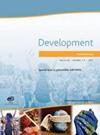增强子网络:通过增强子选择预测细胞特征动态的模型
IF 3.7
2区 生物学
Q1 DEVELOPMENTAL BIOLOGY
引用次数: 0
摘要
了解细胞身份如何由基因组编码并在分化过程中获得是细胞生物学的核心挑战。我们建立了一个名为 "增强子网络"(EnhancerNet)的理论框架,该框架通过转录因子(TF)-增强子相互作用的视角来模拟细胞特性的调控。我们证明,这些相互作用中的自动调节对模型产生了约束,从而简化了动态模型,并可根据观察到的细胞特性对其进行参数化。尽管简单,EnhancerNet 还是再现了关于细胞特性动态的大量实验观察结果,包括增强子选择、细胞命运诱导、通过多能祖细胞状态进行的分层分化,以及通过 TF 过表达进行的直接重编程。该模型进行了具体的定量预测,再现了已知的重编程配方和复杂的造血分化层次,而无需拟合未观察到的参数。EnhancerNet 深入揭示了新细胞类型是如何进化的,并强调了具有动态染色质的远端调控元件在多细胞进化中的功能重要性。本文章由计算机程序翻译,如有差异,请以英文原文为准。
EnhancerNet: A predictive model of cell identity dynamics through enhancer selection.
Understanding how cell identity is encoded by the genome and acquired during differentiation is a central challenge in cell biology. We have developed a theoretical framework called EnhancerNet, which models the regulation of cell identity through the lens of transcription factor (TF)-enhancer interactions. We demonstrate that autoregulation in these interactions imposes a constraint on the model, resulting in simplified dynamics that can be parameterized from observed cell identities. Despite its simplicity, EnhancerNet recapitulates a broad range of experimental observations on cell identity dynamics, including enhancer selection, cell fate induction, hierarchical differentiation through multipotent progenitor states, and direct reprogramming by TF overexpression. The model makes specific quantitative predictions, reproducing known reprogramming recipes and the complex hematopoietic differentiation hierarchy without fitting unobserved parameters. EnhancerNet provides insights into how new cell types could evolve and highlights the functional importance of distal regulatory elements with dynamic chromatin in multicellular evolution.
求助全文
通过发布文献求助,成功后即可免费获取论文全文。
去求助
来源期刊

Development
生物-发育生物学
CiteScore
6.70
自引率
4.30%
发文量
433
审稿时长
3 months
期刊介绍:
Development’s scope covers all aspects of plant and animal development, including stem cell biology and regeneration. The single most important criterion for acceptance in Development is scientific excellence. Research papers (articles and reports) should therefore pose and test a significant hypothesis or address a significant question, and should provide novel perspectives that advance our understanding of development. We also encourage submission of papers that use computational methods or mathematical models to obtain significant new insights into developmental biology topics. Manuscripts that are descriptive in nature will be considered only when they lay important groundwork for a field and/or provide novel resources for understanding developmental processes of broad interest to the community.
Development includes a Techniques and Resources section for the publication of new methods, datasets, and other types of resources. Papers describing new techniques should include a proof-of-principle demonstration that the technique is valuable to the developmental biology community; they need not include in-depth follow-up analysis. The technique must be described in sufficient detail to be easily replicated by other investigators. Development will also consider protocol-type papers of exceptional interest to the community. We welcome submission of Resource papers, for example those reporting new databases, systems-level datasets, or genetic resources of major value to the developmental biology community. For all papers, the data or resource described must be made available to the community with minimal restrictions upon publication.
To aid navigability, Development has dedicated sections of the journal to stem cells & regeneration and to human development. The criteria for acceptance into these sections is identical to those outlined above. Authors and editors are encouraged to nominate appropriate manuscripts for inclusion in one of these sections.
 求助内容:
求助内容: 应助结果提醒方式:
应助结果提醒方式:


